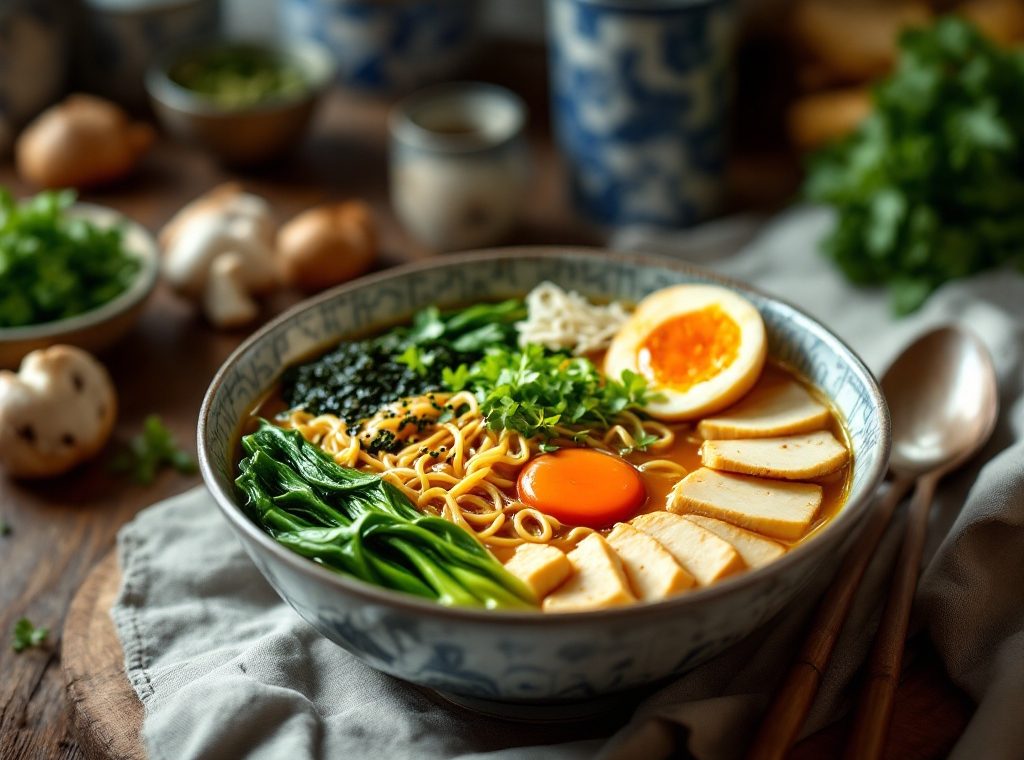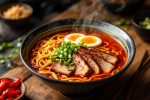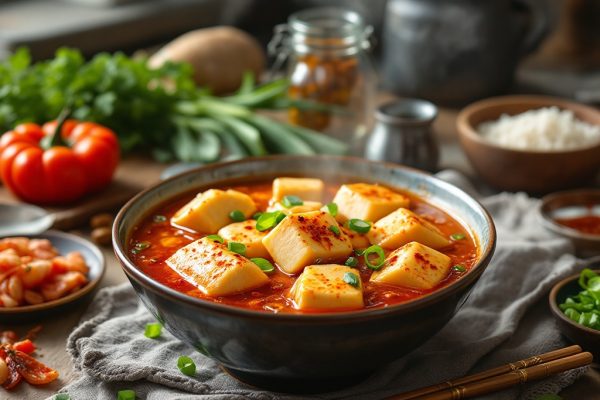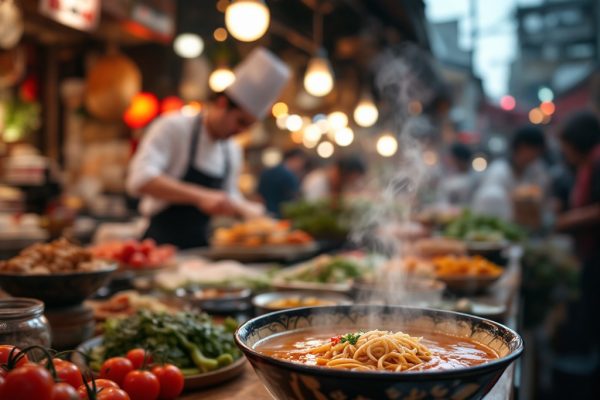Vegetarian Ramen Recipes from Authentic Japanese Ingredients
Craving a flavorful and healthy vegetarian meal? Discover the world of authentic Japanese vegetarian ramen! Learn how to create a rich and savory broth using soy milk, miso, and plant-based ingredients like kombu and shiitake mushrooms. Explore a variety of toppings, from fresh bok choy and nori to protein-rich tofu and tempeh. Dive into our guide and master the art of making delicious vegetarian ramen at home, from quick weeknight meals to impressive culinary creations. Start your ramen journey today!
Important information
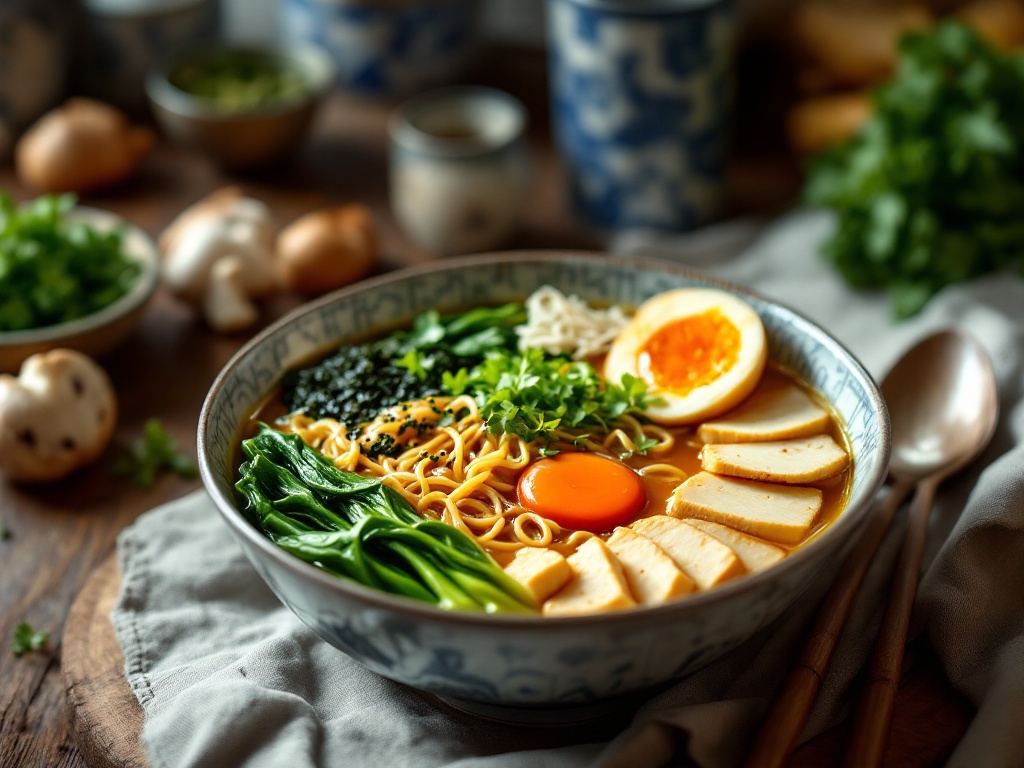
- Vegetarian ramen offers a healthy and customizable meal, featuring a rich broth made with ingredients like miso, soy sauce, or a vegetable-based tonkotsu.
- Key ingredients for authentic vegetarian ramen include soy milk for creaminess, vegan dashi (kombu and shiitake mushrooms) for umami, miso paste for depth, and doubanjiang for spice.
- Fresh or dried egg-free ramen noodles are ideal; try wheat-based for classic texture. Consider rice noodles or gluten-free ramen for dietary needs.
- Customize your ramen with toppings like tofu, tempeh, fresh vegetables (bok choy, spinach, corn, mushrooms), nori, sesame seeds, and chili oil.
- Make it quick: Use store-bought broth, pre-cut vegetables, and instant noodles. A pressure cooker speeds up homemade broth.
Introduction to Vegetarian Ramen Recipes
Vegetarian ramen is a delicious and healthy weeknight dinner option, brimming with fresh vegetables and authentic Japanese flavors. The key is a rich broth, customizable with miso, soy sauce, or even a vegetable-based tonkotsu. Enhance it further with fresh bok choy, mushrooms, protein-rich tofu or tempeh, and a flavorful kick from nori, sesame seeds, and chili oil. For a truly quick meal, prepare the broth and noodles in advance and store them separately. While store-bought vegetarian ramen noodles offer convenience, homemade noodles using flour, water, and kansui are another satisfying choice.
Key Ingredients for Authentic Japanese Vegetarian Ramen
Authentic Japanese vegetarian ramen relies on a few key ingredients. Soy milk creates a creamy, subtly sweet broth with an alluring color. Vegan dashi, made from kombu (kelp) and dried shiitake mushrooms, builds the umami base. Miso paste further enhances the umami, deepening the overall flavor. A final savory, spicy kick comes from doubanjiang, a fermented bean paste.
Soy Milk
Soy milk creates a creamy, subtly sweet, and rich vegetarian ramen broth, enhancing both its color and depth of flavor.
Vegan Dashi – Umami Packed Broth
Vegan dashi gives vegetarian ramen a rich umami flavor. This essential broth, simmered from kombu (dried kelp) and dried shiitake mushrooms, creates the base of the dish. Soy sauce, miso paste, and mirin add further depth, while aromatics like garlic and ginger enhance the savory notes. The result is a deeply satisfying and completely plant-based ramen experience.
Miso
Miso paste delivers a savory punch, deepening flavor and forming the foundation of authentic Japanese ramen. High-quality miso is key to achieving its rich umami taste.
Doubanjiang (Spicy Bean Paste)
Fermented chili bean paste, doubanjiang, adds savory spice and depth to vegetarian ramen, creating a rich, umami broth.
Making the Perfect Vegetarian Ramen Broth
Vegetarian ramen broth can be incredibly flavorful. Starting with kombu and shiitake mushrooms, simmer them for 30 minutes to release their savory umami. Enhance this base with soy sauce, miso paste, and aromatics like garlic, ginger, and onions. A splash of mirin or sake adds depth. This versatile broth can be made ahead and stored in the refrigerator for up to five days or frozen for three months.
Traditional Tonkotsu vs. Vegetarian Ramen
While traditional tonkotsu ramen relies on pork for its umami, a vegetarian version can achieve similar richness. Dried seaweed, mushrooms, and soy sauce build a savory foundation. Miso paste further enhances the flavor, mimicking the satisfying taste of tonkotsu.
Plant-Based Flavor Options
Plant-based ingredients offer a wide range of flavors for vegetarian ramen. Roasted vegetables, such as onions, carrots, and garlic, bring sweetness. Mushrooms, like shiitake or wood ear, contribute earthy notes. For added complexity, experiment with spices like star anise or toasted sesame oil.
Creating a Creamy and Rich Broth
Soy milk creates a creamy base for the rich broth, further enhanced by miso. Warm spices add complexity, while kombu, a dried kelp, lends a savory umami note. Shiitake mushrooms deepen this umami flavor, and aromatics like garlic, ginger, and onions contribute to the broth’s depth. A final touch of soy sauce and mirin rounds out the balanced flavor profile.
Achieving the Umami Flavor of Tonkotsu
Combining tomato paste, dried mushrooms, and kombu with butter creates a surprisingly rich, umami flavor reminiscent of tonkotsu ramen broth. This unique, meat-free blend offers a delicious and flavorful alternative.
Using Plant-Based Ingredients for Depth
Shiitake mushrooms, kombu (kelp), and dried seaweed combine to create a flavorful vegetarian ramen broth, rich in umami. Onions, garlic, ginger, or carrots can further deepen this savory taste, adding complexity. A combination of shiitake mushrooms, kombu (kelp), and dried seaweed creates a flavorful vegetarian ramen broth. This base offers a rich umami flavor. The savory taste can be further deepened and made more complex with additions such as onions, garlic, ginger, or carrots.
Choosing the Right Ramen Noodles
Fresh ramen noodles are typically vegan, consisting of wheat flour, water, salt, and kansui (alkaline water). If fresh noodles are unavailable, dried ramen is a great alternative; just verify the package indicates “egg-free” for a vegetarian dish. While some recipes suggest soba or udon noodles, traditional wheat ramen provides the ideal chewy texture and broth absorption. Experience this difference firsthand by adding fresh ramen to your next bowl. Explore dried vegan options for even more variety.
Fresh Ramen Noodles
Fresh ramen noodles require only a few simple ingredients: wheat flour, water, salt, and kansui, an alkaline water that gives them their characteristic yellow color and satisfying chewiness. These noodles cook remarkably quickly, becoming perfectly tender in just two to three minutes in boiling water. Their ability to readily absorb broth intensifies the ramen experience. You can typically find fresh ramen noodles in the refrigerated section of most Asian grocery stores. If fresh noodles aren’t an option, dried ramen offers a convenient substitute.
Vegan-Friendly Noodles
Traditional wheat-based ramen noodles typically satisfy vegan diets, offering a pleasant chewiness and excellent broth absorption. Available fresh or dried, simply verify the ingredients to ensure they’re egg-free. For those with dietary restrictions, consider these alternatives:
- Rice noodles.
- Gluten-free ramen.
Remember to check accompanying ingredients as well. For instance, use gluten-free soy sauce, or substitute tamari or coconut aminos. Finally, consider other components like broth and toppings for a complete and delicious meal.
Essential Ramen Toppings for Flavor and Texture
Vegetarian ramen bursts with flavor thanks to a variety of vibrant toppings. Enhance your ramen experience with fresh greens, sweet corn, nori, and a soft-boiled egg (optional). Elevate the taste and texture further with bean sprouts, bok choy, and bamboo shoots. A sprinkle of sesame seeds introduces a nutty dimension, while pickled ginger adds a tangy zest.
Tofu, in its many forms, offers excellent protein.
Fresh herbs like cilantro brighten the dish with aroma and color. For a spicy kick, add a dash of chili oil.
Fresh Greens and Sweet Corn
Fresh greens, like spinach or bok choy, brighten the savory broth. A touch of sweet corn adds both sweetness and a pleasant textural element, creating a delicious and balanced flavor.
Nori and Optional Soft-Boiled Egg
Nori seaweed sheets impart a unique, savory flavor and satisfying chewiness to vegetarian ramen. For those open to adding animal products, a soft-boiled egg boosts the richness and protein content. Its creamy yolk further enhances the broth and noodles.
Customizable Ingredients: Protein and Vegetables
Vegetarian ramen thrives with hearty protein sources like tofu, tempeh, and seitan. A colorful array of vegetables further enhances the flavor and texture. Some popular choices include corn, mushrooms, spinach, and bean sprouts. While experimenting with toppings is encouraged, remember the heart of the dish lies in its broth. A delicate balance between toppings and broth creates a truly satisfying ramen experience.
Cooking Techniques for Vegetarian Ramen
Create a flavorful broth by heating vegetable broth in a pot, adding ginger and garlic for depth. Simmer for 30 minutes to enhance the taste.
Cook the ramen noodles according to package directions. Rinse with cold water to prevent sticking.
Prepare your toppings. Chop vegetables such as bok choy, mushrooms, carrots, and green onions. Sauté or blanch them quickly.
Assemble your ramen. Place the cooked noodles in a bowl and ladle the hot broth over them. Arrange your prepared toppings attractively. Add soy sauce or chili oil to taste.
Serve your ramen immediately while hot. For a quicker meal, use pre-cut vegetables and store-bought broth. A soft-boiled egg adds protein.
Customize your ramen with your favorite vegetables and spices.
Step-by-Step Cooking Steps
Cook fresh noodles in boiling water for 2–3 minutes, or dried noodles for 2–5 minutes.
Rinse the noodles with cold water and set aside.
In a saucepan, gently simmer your vegetarian broth.
Divide the noodles evenly among bowls and ladle the hot broth over them.
Add your favorite toppings, such as corn, greens, nori, tofu, or other vegetables, arranging them attractively.
Serve your ramen immediately and enjoy.
Tips for a Quick and Easy Recipe
Speed up your ramen night with pre-cut veggies like carrots, bean sprouts, and spinach. Swap homemade broth for the store-bought kind, and choose instant noodles over dried ones. A pressure cooker drastically cuts down broth-making time. Prepping toppings like soft-boiled eggs or marinated tofu in advance also shaves minutes off your total prep time. Here’s a step-by-step guide to faster ramen:
Use pre-cut veggies. carrots, bean sprouts, and spinach are great choices.
Opt for store-bought broth instead of making your own.
Choose instant noodles for the quickest preparation.
If making broth, use a pressure cooker to save time.
Prep toppings like soft-boiled eggs or marinated tofu ahead of time.
Storing and Freezing Vegetarian Ramen
To maintain the freshness of your vegetarian ramen broth, store it in an airtight container in the refrigerator for up to three days. For longer-term storage, freeze the broth in a freezer-safe container for up to two months. Cooked noodles should be stored separately from the broth. To freeze noodles, spread them on a baking sheet until solid, then transfer them to a freezer-safe bag for up to one month.
How to Store Broth
Store your broth in an airtight container in the refrigerator to keep it fresh for up to five days.
Freezing Instructions for Long-Term Storage
Allow the broth to cool completely.
Transfer it to airtight containers or freezer bags, leaving an inch of headspace for expansion.
Freeze for up to three months.
Enjoying Vegetarian Ramen as a Comfort Food
Vegetarian ramen offers a healthy and comforting weeknight meal that is both satisfying and customizable to your taste. From spicy miso to creamy coconut milk, the broth options alone offer exciting variety. You can even try tsukemen, where noodles and broth are served separately. Boost the protein and texture with tofu, tempeh, or seasonal vegetables.
- bok choy,
- spinach,
- carrots,
- bell peppers,
- snap peas,
- mushrooms.
A sprinkle of green onions, bean sprouts, or corn adds a touch of freshness. For the noodles themselves, chewy wheat-based ramen is a popular choice.
Healthy Weeknight Meal Option
Vegetarian ramen is a quick, flavorful, and healthy weeknight meal that is both satisfying and nutritious. Ready in minutes, this versatile dish can be customized with your favorite toppings, such as tofu and a variety of vegetables, so everyone can enjoy a perfect bowl.
Vegan Variations and Options
Craving vegan ramen? Ditch the egg and explore flavorful broth options, such as spicy miso or creamy coconut milk. Regional variations like tsukemen, where noodles and broth are served separately, offer even more choices. Enhance your bowl with protein-packed tofu or tempeh, and add seasonal vegetables for exciting textures and flavors.

